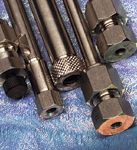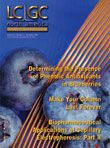Extending Column Life
LCGC North America
No column lasts forever, but in this month's installment of "LC Troubleshooting," John Dolan offers some tricks to help extend a column's life.
Read no further. Want your liquid chromatography (LC) column to last forever? Never open the box! Not very practical advice, because the fact is that all columns fail sooner or later. However, there are some tricks that will help you extend a column's life. This month's "LC Troubleshooting" discusses some practices that you might find useful to make your column last longer.

John W. Dolan
Filter
One of the most common symptoms of column failure is high column back pressure. Back pressure rises as particulate matter accumulates on the inlet frit of the column. Columns packed with 5-μm packing use 2-μm porosity frits to contain the packing. When 3-μm packings are used, the inlet frit can be either 2 μm or 0.5 μm, depending on the manufacturer. To a certain extent, particulate matter buildup on the frit is unavoidable, but there are several simple practices that can slow this process.

Mobile phase: Over the lifetime of the average column, tens, or even hundreds of liters of mobile phase pass through the column. Any particulate matter in the mobile phase usually ends up on the column frit. Filtration of all mobile phase through a 0.5-μm porosity membrane filter should eliminate particulates originating in the mobile phase. However, nearly all high performance liquid chromatography (HPLC)-grade solvents are filtered through a 0.2-μm porosity filter during manufacturing, so additional filtration (especially with a more porous filter) might not be beneficial. HPLC-grade water prepared with a water purification system generally includes a 0.2-μm final filter, so water should not require additional filtration, either. In my laboratory, our standard operating procedure allows us to bypass the filtration step if mobile phase is prepared only from HPLC-grade liquids (acetonitrile, methanol, water, and so forth). If solids, such as buffer salts, are used in the mobile phase, filtration is required. Even though the buffer might be chemically pure, physical contaminants, such as fibers scraped from the bottle cap liner, often are present. When in doubt, filter the mobile phase. And don't forget to cover the mobile phase reservoirs to prevent dust from entering. A loose screw-cap or a piece of aluminum foil works well; do not use one of the polymeric laboratory film products — it might not be compatible with the mobile phase solvents.
Seals: Pump piston seals and injector valve rotor seals are made of polymeric materials that gradually wear over time. Fragments of the seal eventually make their way downstream and end up on the column frit. Seal wear cannot be prevented, but it can be minimized by ensuring that buffers and other salts are not allowed to stand in the LC system when it is not in operation. These salt solutions can evaporate on the piston surface behind the pump seal, creating an abrasive coating of salt crystals that will damage the seal over time. It is best to flush the LC system with nonbuffered solvent (for example, acetonitrile–water) before shutdown so that any buffer residues are removed. If high-salt mobile phases are used, such as buffers > 50 mM in concentration or ion-exchange mobile phases, it is wise to use the seal-flush feature available on most LC pumps. This is simply a liquid path behind the pump seal that can be flushed with water or water–alcohol to remove any salt residues. There is not a similar flushing feature available for most sample injectors, but if you avoid the use of nonvolatile buffers in the autosampler wash, you will reduce the likelihood of rotor abrasion. Piston seals can last for 6–12 months — check your system maintenance records to determine a reasonable replacement cycle. I recommend replacing the pump seals before they fail, or at least once a year during annual maintenance. Injector rotors can last for 20,000 cycles or more. If your autosampler keeps track of the number of rotor cycles, you could include replacement in a preventive maintenance plan, based upon the number of cycles. Rotor seal failure is so rare in my laboratory that we just wait until we have problems before replacing the seal, which can be after several years of use.
Solvent reservoir filter: The frit on the tubing connecting the reservoir to the pump is an additional precaution to keep particulate matter from entering the system. This frit should not be considered an alternative to filtering the mobile phase, but rather a safety device to remove any dust that might enter the reservoir or other inadvertent contamination. A 5-or 10-μm porosity frit will serve this purpose well, without generating significant resistance to flow that might result in pump starvation. A simple test for frit blockage is to see if mobile phase siphons freely through the frit and tubing. Just disconnect the inlet tubing at the proportioning manifold (low-pressure-mixing system) or pump inlet (high-pressure mixing). With mobile phase siphoning through this tubing, I like to see delivery of 10 times the pump requirement. For example, if you normally operate the pump at 1–2 mL/min, accept no less than 10–20 mL/min through the siphon. If the flow is less than desired, replace the frit.
Samples: Particulate matter from injected samples is the most common source of column frit blockage. Some workers filter all samples before injection. Individual syringe-type filters can be used or if you are using automated sample preparation, 96-well filter plates are available. I have mixed feelings about the use of sample filters because of the expense, inconvenience, and validation implications. Filtration can add a dollar or more to the cost of sample preparation, not an insignificant cost for a laboratory performing routine analysis on hundreds or thousands of samples per month. 96-well filter plates are easy to automate, but the use of syringe filters is time-consuming. At the top of my list, though, are considerations of sample loss and validation. Every filter has a finite hold-up volume, so sample loss occurs when filters are used. This is not important if you have several milliliters of sample, but if your sample is limited to 100 μL or less, a significant portion of the sample can be lost in the filter. Does anything leach from the filter that might interfere with the chromatographic assay? Does the filter selectively adsorb anything from your sample that might affect the assay results? These concerns require that the filtration process be included in the method validation process and generally preclude selective filtration of some samples and not others. As an alternative, the samples can be centrifuged in a bench-top centrifuge (for example, at 10,000 rpm) for 5 min. Following filtration, the sample is transferred to the injection vial or plate.
In-line filter: One of the least expensive and most effective ways to protect the column from particulate contamination is to use an in-line filter. This 0.5-μm porosity frit is mounted just downstream from the autosampler, ahead of the column (and guard column, if used). The in-line frit will trap particles that would otherwise contaminate the column inlet frit. When the system back pressure rises, change the in-line frit and you should be back in business. These devices are inexpensive and can be purchased from any LC supplies vendor. Some manufacturers design their columns so that the in-line filter frit is built into the analytical column (sometimes called a double frit). Disposable tube fittings that contain a frit also are available. Be sure to keep plenty of replacement frits on hand. I consider the in-line frit a mandatory part of every LC system.
Guard column: A guard column is simply a miniature LC column that contains packing material similar to that in the analytical column. It also has a frit at each end, and the frits trap particulate matter. However, the porosity of the guard column frits generally is the same as the analytical column (for example, 5 μm), so it is beneficial to use an in-line 0.5-μm frit even if a guard column is used.
Column inlet frit: It might or might not be possible to change the frit at the column inlet. Some columns use pressed-in frits that cannot be replaced. 10–15 years ago, when columns were not packed as well as they are today, many workers routinely replaced the column inlet frit. In fact, many columns came with an extra frit or two, just for this purpose. Today's columns, however, are packed at higher pressure. The resulting column will generally ooze packing if the frit is removed — this can irreversibly damage the column, so frit replacement is not recommended for most analytical columns today. An alternative is to backflush the column. Just remove the column from the system and connect the outlet end to the pump and pump 10–20 mL of solvent through the column to displace any particles from the frit. (Be sure to pump directly from the column to waste and not through the detector to keep contaminants out of the detector.) After reverse-flushing, I prefer to leave the column in the reversed direction — I have seen many cases in which the pressure rise returned when the column was placed back in the normal flow direction. Most 5-μm particle silica-based columns are amenable to reversal without damage. However, some manufacturers of 3-μm particle columns use a 2-μm frit at the inlet end and a 0.5-μm frit at the outlet of the column; reversal of these columns can result in leakage of packing and damage to the column. Always consult the column manufacturer's care-and-use instructions before reversing any column.
Sample Cleanup
There are two types of contamination that will ruin a column — physical and chemical. The previous discussion presented several techniques to minimize problems from physical contamination by particles from various sources. Next, let's look at what can be done to minimize chemical contamination.
Mobile phase compatibility: Before considering sample cleanup, it should go without saying that the mobile phase should be compatible with the column. For the reversed-phase, silica-based columns that most of us use on a daily basis, pH is the most important parameter. As a general rule, the bonded phase is hydrolyzed from the column packing at pH < 2 and the silica dissolves at pH > 8, but these are not hard-and-fast rules. Some columns are specifically designed for use under high-or low-pH conditions. However, unless you know otherwise, keep the mobile phase pH within the pH 2–8 region (or more conservatively, pH 2.5–7.5) for maximum column stability. Again, consult the manufacturer's care-and-use instructions for specific directions for your column.
Chemical contamination: The whole purpose of the chromatographic process is to separate different chemical compounds from each other. Some are more retained and others are less retained. Poorly retained materials generally are not a problem, in terms of column contamination. These materials wash through at the solvent front or early in the chromatogram, and can cause problems with quantification, but they do not remain on the column. On the other hand, materials that are strongly retained can build up over time and change the separation or ruin the column. Let's consider these strongly retained materials in two classes. One group contains compounds that are strongly retained, but can be washed off the column with a strong solvent. The other group includes materials that cannot be removed from the column. We will consider only reversed-phase separation, in which both groups are less polar (more hydrophobic) than the sample.
Strongly retained compounds: Materials that are strongly retained under analytical conditions often can be removed from the column when a strong solvent, such as 100% acetonitrile or methanol, is used to flush the column. For isocratic methods, this flushing can be done at the end of a batch of samples before the LC system is shut down. Generally, 10–20 mL of 100% strong solvent will be sufficient to remove strongly retained materials. With gradient-elution methods, each run can be concluded with a ramp or step-gradient to strong solvent to remove hydrophobic materials. Sometimes, a different mobile phase condition, such as a change in pH or buffer salt strength will be beneficial. Usually one of these techniques will result in satisfactory removal of late-eluted materials.
Irreversibly retained materials: Some samples contain constituents that bind irreversibly to the column or have such large retention characteristics, even under strong solvent conditions, that they might be considered permanently bound to the column. Often these compounds are proteins, lipids, and other high-molecular weight, hydrophobic compounds if the sample is biological in origin. If the sample is chemical in nature, polymers and other high-molecular-weight, hydrophobic compounds also might be present. At other times, sample constituents might not be soluble in the mobile phase and precipitate at the head of the column. Sometimes, reverse-flushing the column with strong solvent will remove some of the strongly bound material, but often this practice is only marginally effective. As chemical junk builds up on the column, packing pores can become blocked, the packing surface can become coated, or active retention sites on the stationary phase can be permanently blocked. All these actions change the retention characteristics of the column. Eventually, the column must be replaced.
Sample pretreatment: The best way to deal with strongly and irreversibly retained materials is to remove them before injecting the sample. Just as we use physical filtration techniques to remove particulate matter from the sample and mobile phase, we can use chemical cleanup steps to remove unwanted compounds from the sample.
Perhaps the simplest way to clean up the sample is to use a guard column. A guard column of the same packing as the analytical column will trap strongly retained material in the same manner as the column does. Sometimes, the guard column can be flushed to extend its life (flush the guard column to waste or the contaminants will be flushed onto the analytical column). However, the guard column is designed as a disposable device and should be discarded regularly. You will have to determine for your samples how long the guard column will last, but guard column lifetimes of 50–100 samples or more can be reasonable. Some workers replace the guard column on a time-basis, such as once a week.
The best way to cleanup the sample is to use some kind of chemical or chromatographic cleanup. The most common techniques are precipitation to remove proteins, liquid–liquid extraction, and solid-phase extraction. A complete discussion of sample cleanup is beyond the space allowances for this installment of "LC Troubleshooting," so we will leave that for another time. Consult Ron Majors' "Sample Preparation Perspectives" column for a regular discussion of sample preparation.
Conclusions
There are quite a few techniques that can be used to extend the useful life of an LC column. However, the column should be considered a disposable item. This might be difficult to accept, considering that the typical column costs $500 or so. Think of the cost of the column in view of the overall analysis costs. Typical sample charges for an LC–UV assay by a contract research laboratory are in the range of $50 per sample. If the column lasts for 500 injections, this means that the column contributes $1 to this total, or 2% of the cost. Many workers get 1000–2000 samples analyzed before a column dies, so the cost per sample would be even less. So, use common sense — institute reasonable preventive strategies, but do not be mislead by investing more in sample cleanup than you recover in extended column life. After all, you really shouldn't expect the column to last forever.
John W. Dolan "LC Troubleshooting" Editor John W. Dolan is Vice-President of BASi Northwest Laboratory of McMinnville, Oregon; a Principal Instructor for LC Resources, Walnut Creek, California; and a member of LCGC's editorial advisory board. Direct correspondence about this column to "LC Troubleshooting," LCGC, Woodbridge Corporate Plaza, 485 Route 1 South, Building F, First Floor, Iselin, NJ 08830, e-mail John.Dolan@LCResources.com
New Method Explored for the Detection of CECs in Crops Irrigated with Contaminated Water
April 30th 2025This new study presents a validated QuEChERS–LC-MS/MS method for detecting eight persistent, mobile, and toxic substances in escarole, tomatoes, and tomato leaves irrigated with contaminated water.
University of Tasmania Researchers Explore Haloacetic Acid Determiniation in Water with capLC–MS
April 29th 2025Haloacetic acid detection has become important when analyzing drinking and swimming pool water. University of Tasmania researchers have begun applying capillary liquid chromatography as a means of detecting these substances.
Prioritizing Non-Target Screening in LC–HRMS Environmental Sample Analysis
April 28th 2025When analyzing samples using liquid chromatography–high-resolution mass spectrometry, there are various ways the processes can be improved. Researchers created new methods for prioritizing these strategies.

.png&w=3840&q=75)

.png&w=3840&q=75)



.png&w=3840&q=75)



.png&w=3840&q=75)












